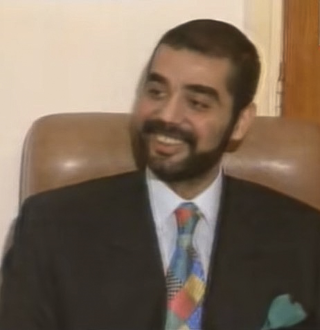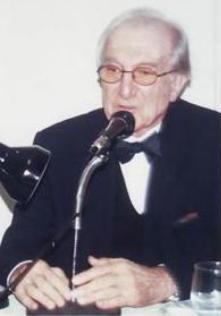
Saddam Hussein was an Iraqi politician and revolutionary who served as the fifth president of Iraq from 1979 to 2003. He also served as prime minister of Iraq from 1979 to 1991 and later from 1994 to 2003. He was a leading member of the revolutionary Arab Socialist Ba'ath Party and later its Iraqi regional branch. Ideologically, he espoused Ba'athism, a mix of Arab nationalism and Arab socialism, while the policies and political ideas he championed are collectively known as Saddamism.

Uday Saddam Hussein was an Iraqi politician, and the elder son of Saddam Hussein. He held numerous positions as a sports chairman, military officer and businessman, and was the head of the Iraqi Olympic Committee, Iraq Football Association, and the Fedayeen Saddam.
The Victory Arch, officially known as the Swords of Qādisīyah, and popularly called the Hands of Victory or the Crossed Swords, are a pair of triumphal arches in central Baghdad, Iraq. Each arch consists of a pair of outstretched hands holding crossed swords. The two arches mark the two entrances to Grand Festivities Square and the parade ground constructed to commemorate the Iran–Iraq War, started and led by Iraq's then-president Saddam Hussein. The arches were opened to the public on 8 August 1989. It is one of Baghdad's visitor attractions and near to the Monument to the Unknown Soldier.

Amir Hamudi Hasan al-Saadi or Amer al-Sadi, "the organizational genius behind the Iraqi superweapons program," was Saddam Hussein's liaison with the UN inspectors in the runup to the 2003 invasion of Iraq. Like the defector Hussein Kamel al-Majid, he insisted Iraq had destroyed its prohibited weapons. He was dismissed by the US as a liar. There was a subsequent failure to uncover weapons of mass destruction by the Iraqi Survey Group.

Naseer Shamma is an Iraqi musician and oud player.

Al-Firdos Square is a public open space in central Baghdad, Iraq. It is named after the Persian word Ferdows, meaning 'paradise'. The site has been the location of several monumental artworks.

Al-Karkh or just Karkh is historically the name of the western half of Baghdad, Iraq, or alternatively, the western shore of the Tigris River as it ran through Baghdad. The eastern shore is known as al-Rusafa. Historically, al-Karkh has been a commerce market during the Abbasid Caliphate, located outside the main Round City due to safety concerns. It saw many exports and was the main business place for merchants and craftsmen. Al-Karkh has also historically suffered from infighting, fire, and floods that impacted its population and topography.

Al-Shaheed Monument, also known as the Martyr's Memorial, is a monument designed by Iraqi sculptor Ismail Fatah al-Turk and situated in the Iraqi capital, Baghdad. It was originally dedicated to the Iraqi soldiers killed in the Iran–Iraq War and has since grown to become generally considered to be a commemoration of all Iraqi martyrs.

Al-Mansour or just Mansour is one of the nine administrative districts in Baghdad, Iraq. It is in western Baghdad and is bounded on the east by al-Karkh district in central Baghdad, to the north by Kadhimiya, to the west by Baghdad International Airport, and to the south by Baghdad Airport Road, on the other side of which is al-Rashid district.
Steve Mumford is an American painter. His practice has recently included the depiction of scenes from American wars in Iraq and Afghanistan. Typically he works in large, realist oil paintings, as well as watercolor on paper. He is the son of mathematician David Mumford.

The Monument to the Unknown Soldier is a monument in central Baghdad designed by Italian architect Marcello D'Olivo based on a concept by Iraqi sculptor Khaled al-Rahal and constructed between 1979 and 1982. It was dedicated to the martyrs of the Iran–Iraq War. In 1986 the national square of Iraq, Great Celebrations square, was built near the monument, and two other monuments were built close to the square in memory of the martyrs. In 1983, the Al-Shaheed Monument on the River, was opened and in 1989 the newly built Victory Arch became the entrances to the square. The Unknown Soldier's Monument represents a traditional shield (dira'a) dropping from the dying grasp of an Iraqi warrior. The monument also houses an underground museum.
Bassem Hamad al-Dawiri was an Iraqi sculptor and artist. He helped create a Baghdad artist association, called the "Survivors' Group" following the fall of the Saddam Hussein government in 2003.

Rifat Chadirji was an Iraqi Turkmen architect. He was often referred to as the father of modern Iraqi architecture, having designed more than 100 buildings across the nation.

On April 9, 2003, during the US invasion of Iraq, a large statue of Saddam Hussein in Baghdad's Firdos Square was destroyed by Iraqi civilians and United States Marines. The event received global media coverage, wherein it came to symbolize the end of Saddam's rule in Iraq.

Mohammad Ghani Hikmat was an Iraqi sculptor and artist credited with creating some of Baghdad's highest-profile sculptures and monuments and was known as the "sheik of sculptors". He is also known as an early member of Iraq's first 20th-century art groups, including Al-Ruwad and The Baghdad Modern Art Group; two groups that helped to bridge the gap between tradition and modern art. He was also instrumental in recovering many of Iraq's missing artworks, which were looted following the 2003 invasion.

The Mask of Warka, also known as the Lady of Uruk, dating from 3100 BC, is one of the earliest known representations of the human face. The carved marble female face is probably a depiction of Inanna. It is approximately 20 cm tall, and was probably incorporated into a larger wooden cult image, though it is only a presumption that a deity is represented. It is without parallels in the period. It is in the National Museum of Iraq, having been recovered undamaged after being looted during the United States invasion of Iraq in 2003.
Ala Younis is a Kuwaiti research-based visual artist, painter, and curator, based in Amman, Jordan. Younis initiates journeys in archives and narratives, and reinterprets collective experiences that have collapsed into personal ones. Through research, she builds collections of objects, images, information, narratives, and notes on why/how people tell their stories. Her practice is based on found material, and on creating materials when they cannot be found or when they do not exist.

Khaled Al-Rahal was an Iraqi painter and sculptor and one of the leaders of the modern art movement in Iraq. Described as one of the "pillars of modern Iraqi art," he was responsible for executing a number of high-profile public monuments in Baghdad in the mid-20th century.
Nida Kadhim is an Iraqi sculptor, noted for producing a number of monumental works for Baghdad's city centre, some of which are still standing, while others were demolished or looted following the 2003 Iraqi invasion.
Kahramana is a fountain located in Baghdad's Sa'adoon Street depicting a scene from the legend of Ali Baba and the Forty Thieves; a story taken from One Thousand and One Nights in which the slave girl Marjana outwitted the thieves by tricking them into hiding inside jars over which she poured hot oil. The statue was officially opened in 1971 and was the work of the Iraqi sculptor, Mohammed Ghani Hikmat. It has become one of Baghdad's most iconic public artworks. In the aftermath of the US-led invasion of 2003, the work assumed new meanings for the Iraqi people.
















